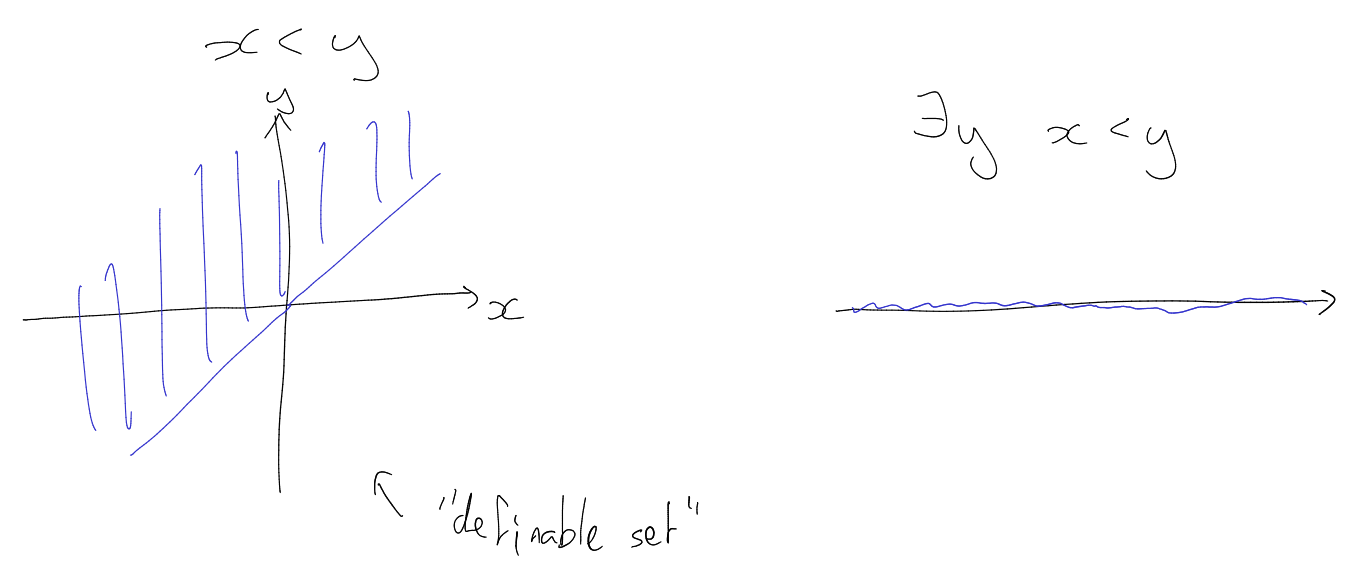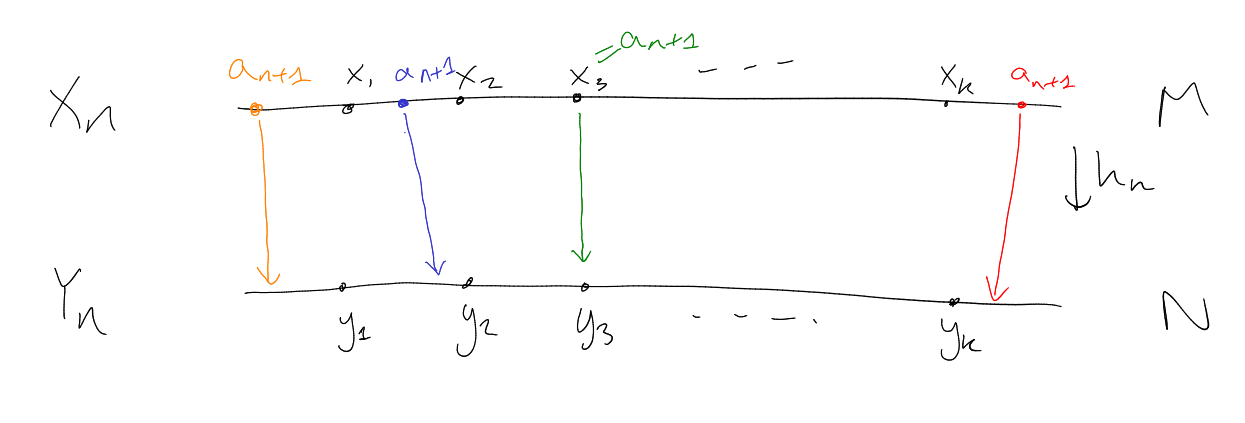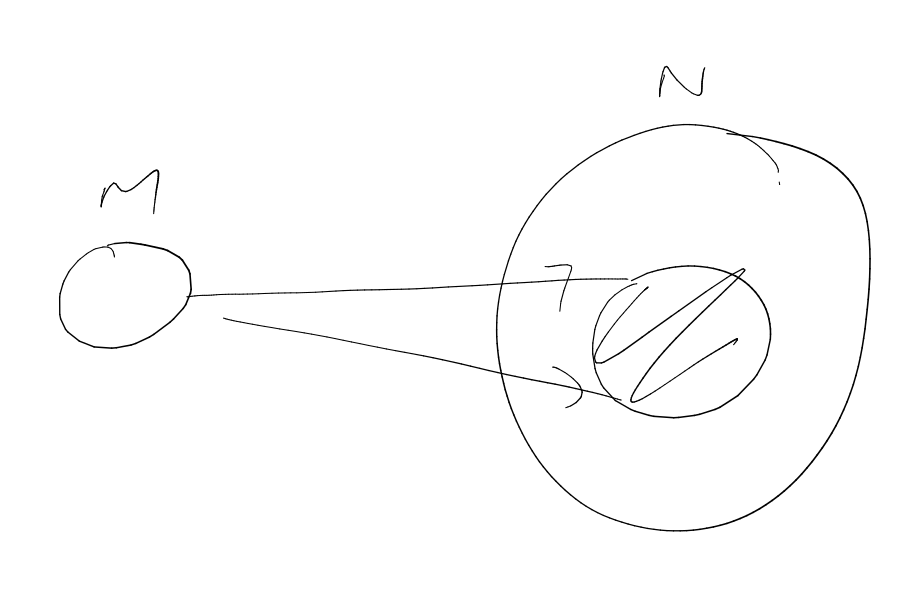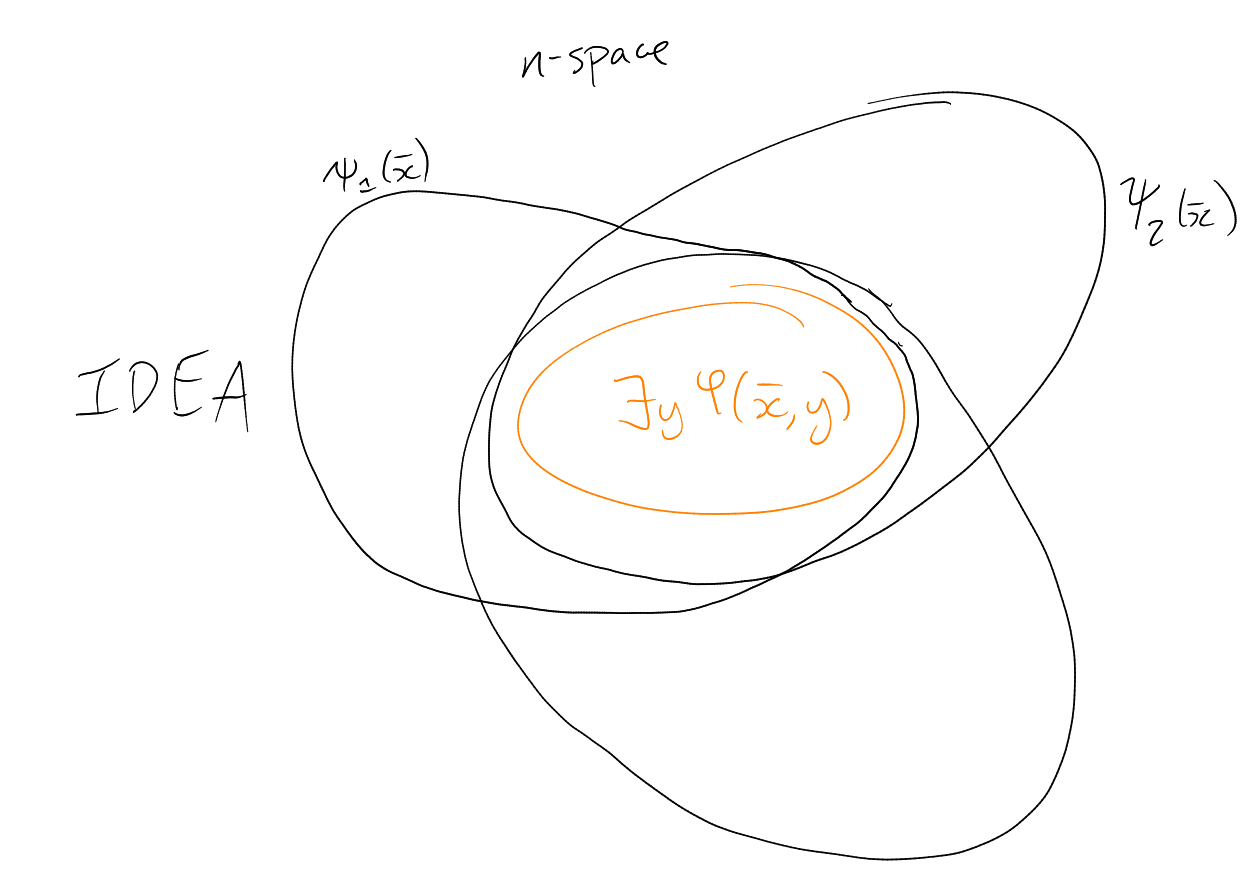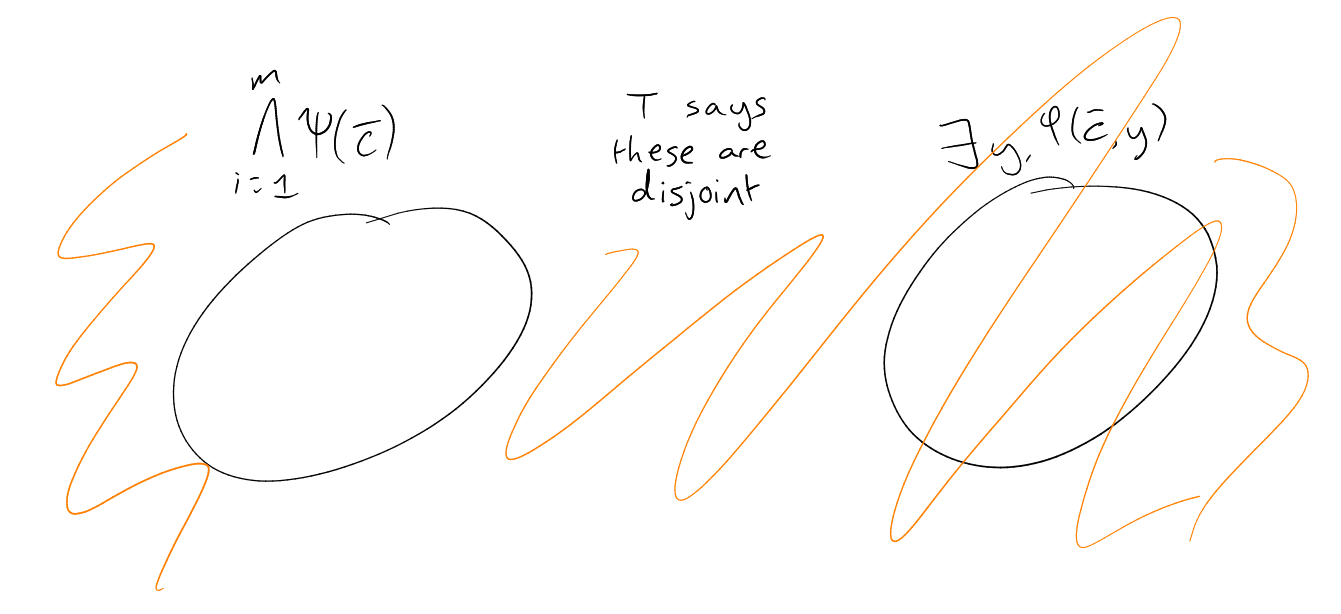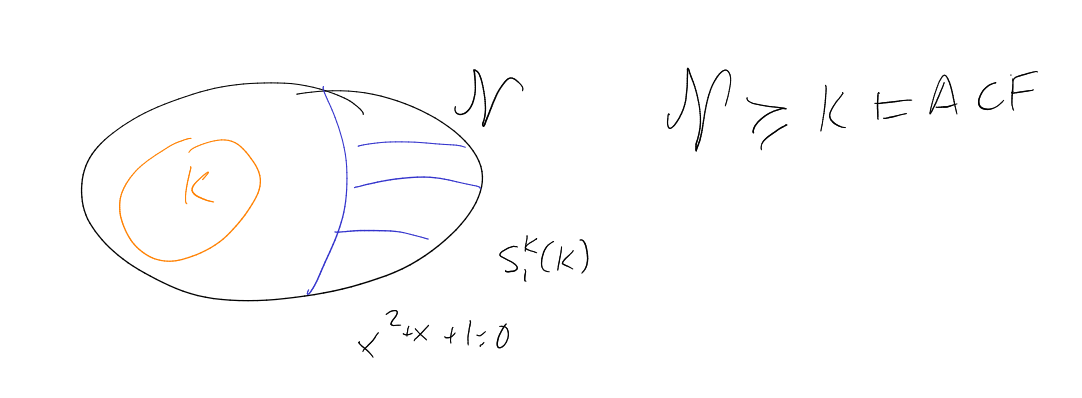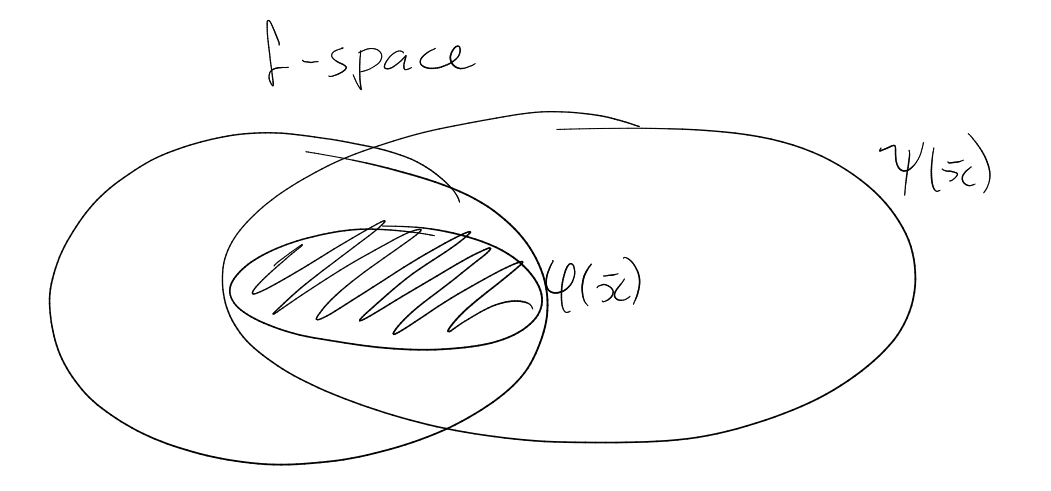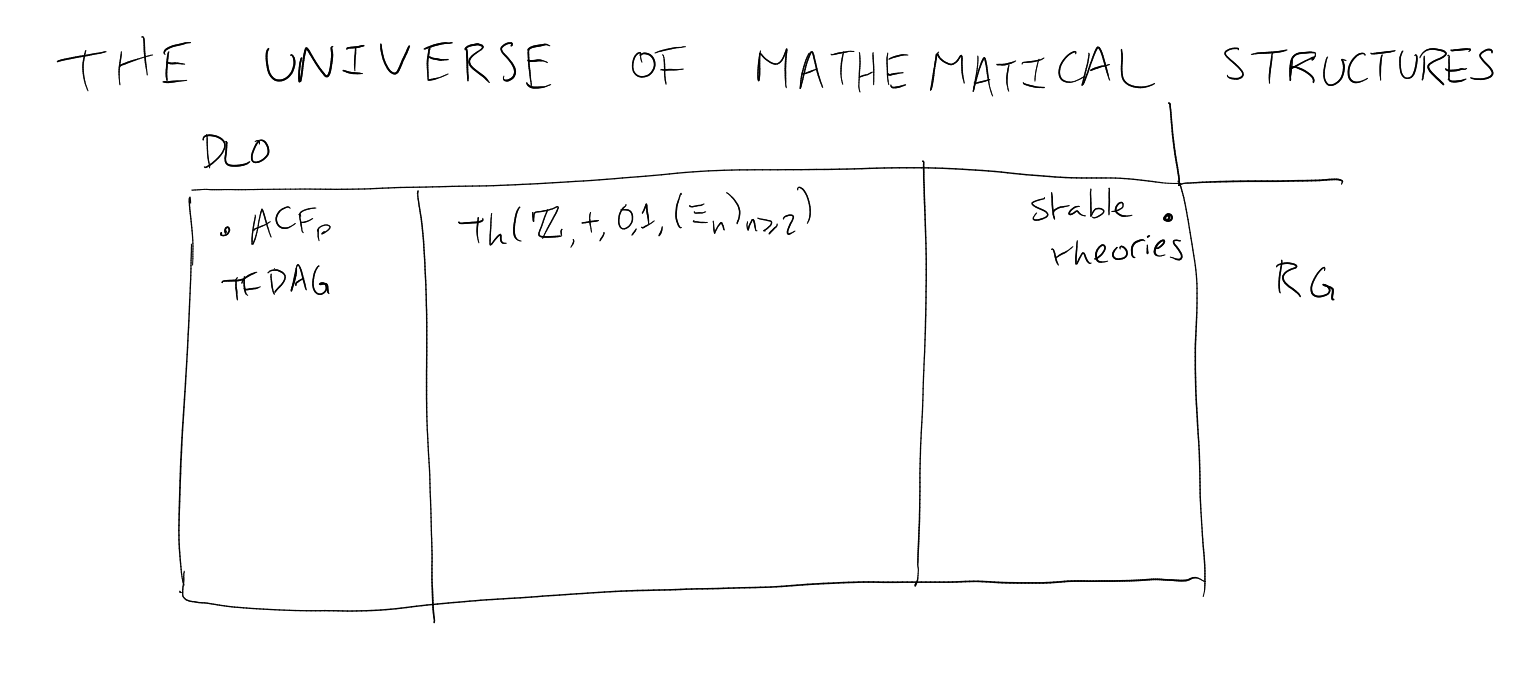Model Theory
Lectured by Charlotte Kestner
Contents
Introduction
Example.
is not the same as .
is decidable (there exists an algorithm to decide whether a given sentence is true or false in the model).
However, is
not decidable (Gödel’s completeness theorem).
Example.
-
(1)
-
(2)
(where
is an -vector
space, and
is the map
for any ).
These structures are both strongly minimal.
Definition (Strongly minimal).
A theory is strongly minimal if all formulas in one variable are either finite
or co-finite.
For the
example: formulas in one variable are polynomial equations or inequations, so solution set is always either
finite or cofinite (recall Fundamental Theorem of Algebra).
For the vector space example: the formulas in one variable are of the form
or
.
Cheats:
-
Boolean combinations and quantifiers:
Need quantifier elimination (boolean combinations are easy to deal with).
-
Elementary extensions (chapter 1).
Interestingly: strongly minimal structures all carry notion of dimensions. For example:
-
In
this is transcendence degree.
-
In ,
this is linear dimension.
If interested in further reading: see
0 Review of First Order Logic
0.1 Languages
|
|
Example.
-
,
with example sentences ,
.
-
:
.
-
:
.
Convention: all languages include .
0.2 Structures
Definition.
Given a language ,
an -structure
is a triple
is an underlying set.
Convention: .
:
for every -ary
we have
a function .
:
for every -ary
,
we have ,
which is a subset of .
: for every
, we
have ĉ,
with ĉ.
-
and
are both -structures.
-
and
are both -structures.
0.3 Formulas / sentences
-
Terms: made of variables, constant symbols and function symbols in a ‘sensible way’
-
Atomic formulas: Plugging terms into one relation symbol
-
Formulas:
-
Boolean combinations ()
-
Quantifiers ()
in a ‘sensible way’:
|
|
A formula with free
variables defines a subset of .
Example.
-structure
.
Formulas with no free variables are called sentences.
In an -structure
, these
are either:
In formula with free
variables, we can plug a tuple .
We say
satisfies at
, and we write
(models /
satisfies) if
is true in .
Definition.
A set of sentences
is satisfiable in
if for all ,
.
Theorem (Compactness Theorem).
Let
be a set of -sentences.
is satisfiable if and only
if every finite subset of
is satisfiable.
( is satisfiable if there
is an -structure
such
that is
satisfiable in )
Corollary (Upward Löwenheim Skolem).
Any theory that has either:
has arbitrarily large models.
1 Complete Theories
Definition 1.1 ( models a sentence).
Let
be an -theory,
an -sentence.
Then
if every model of
is a model of .
Example.
.
.
Definition 1.2 (Complete theory).
An -theory
is complete if for every -sentence
,
either
or .
Example 1.3.
is not complete,
as (for example) it doesn’t imply
or .
Definition 1.4 (Theory of ).
Let be an
-structure. Then
the theory of
|
|
(can be written
when
is clear).
Definition 1.6 (Elementarily equivalent).
Two -structures
are elementarily equivalent if their theories are equal.
Given -structures
,
we write
to mean .
Note.
This is an equivalence relation on
-structures.
Exercise: Let
be an -theory.
Then the following are equivalent:
Example 1.7.
Let
and ,
where
This forms the theory of infinite sets. Any infinite set models this, but also in this language we have that any
two infinite sets are elementarily equivalent. For example,
Question: How do we prove a theory is complete?
Theorem 1.8 (Los-Vaught test).
Assuming that:
-
is an -theory
-
has no finite models
-
Proof.
Assume
is not complete, i.e. there is some -sentence
such that
and
are both satisfiable.
So we have ,
.
From (a) we know
are infinite. By Lowenheim-Skölem, we know we have
and
with ,
contradicting (b). □
Reminder: By combining Lowenheim-Skölem up and down, we get the following statement:
If an -theory
has an infinite model,
then it has a model of size
for every .
2 Homomorphisms
Definition 2.1 (Homomorphism).
Let
be -structures.
A function is an
-homomorphism
if:
-
(i)
For an -ary
function symbol ,
and
we have
|
|
-
(ii)
For an -ary
relation symbol ,
and
we have
|
|
-
(iii)
For any constant symbol ,
.
We write if
is an
-homomorphism.
If is also injective then this
is called an -embedding.
If is also bijective then this
is called an -isomorphism.
Theorem 2.2.
Assuming that:
-
-
an -formula
-
Then |
|
Proof.
Let .
Step 1: Terms. Proof by induction on term complexity. For the base case:
For the inductive step: Let be
an -ary function symbol. Assume
that the claim holds for whose
free variables are amongst .
Suppose .
Given ,
we have
Step 2: Formulas. Base case: atomic formulas. Suppose
is
.
Then:
Case where
is left
as an exercise.
Inductive step: Assume statement holds for
and .
-
,
left as an exercise.
-
(then
will follow since it can be expressed using ).
Let .
Then
Notation.
Write if
there is an -isomorphism
between them.
Corollary 2.3.
If ,
then .
Remark.
So far we have two equivalence relations on
-structures:
and
.
Corollary 2.4.
is an -embedding
if and only if the conclusion of Theorem 2.2 holds for all quantifier free formulas
.
Definition 2.5 (Elementary embedding).
An
-homomorphism
is an elementary
-embedding if for
any -formula
and any
(with
) we
have
Definition 2.6 (Substructure).
Let
and
be -structures
with .
Let
be the inclusion map. Then we say that
is a substructure (respectively elementary substructure) of ,
written
(respectively )
if
is an -embedding
(respectively elementary -embedding).
We may also say
is an extension (respectively elementary extension) of .
Remark.
-
The notion of substructure generalises subgroups, subrings, induced subgraphs.
-
Elementary substructure is stronger (more particular to model theory).
-
If
then
and .
Example 2.7.
Let
and .
Then
and
but .
Why? Consider ,
. Then
, but
.
Theorem 2.8 (Tarski-Vaught Test).
Assuming that:
Then the following are equivalent:
-
(i)
is an elementary -embedding
-
(ii)
For every first order formula
and every ,
if there exists
such that
then there exists
such that .
3 Categoricity
Definition 3.1 (-categorical).
An -theory
is -categorical
if it has a unique model of size
up to isomorphism.
For now, assume our theories have infinite models and that
.
So we can find four different cases... surprisingly this is all.
Theorem (Morley’s Categoricity Theorem 1965).
Assuming that:
-
is a
complete theory in a countable language
-
We do not prove this theorem in this course. The statement is examinable, but the proof is not.
Dense linear orders (with no endpoints)
Definition 3.3 (Theory of dense linear orders).
Let
. We
define the theory in axioms:
-
(i)
Irreflexive: .
-
(ii)
Transitive: .
-
(iii)
Antisymmetric: .
-
(iv)
Dense: .
-
(v)
No endpoints: .
Note.
DLO is consistent, because .
Proof.
Let
with
countable. We need to construct an -isomorphism
,
i.e. an order preserving bijection.
We will use the back and forth method.
Let
and .
We construct a series of functions
such that:
-
(i)
is an order-preserving bijection.
-
(ii)
for each .
-
(iii)
,
.
Once we have done this, is an
order-preserving bijection
(i.e. an -isomorphism).
Use induction.
Base case: ,
,
.
Inductive step: Suppose
as required.
“Forth”: Construct an order preserving bijection
extending
with .
Enumerate
with .
Let so
that .
Define
where
is chosen according to the following cases:
-
If
for some ,
then put .
-
If
for all
then choose
such that
for all
(possible since no endpoints).
-
If
for all ,
then choose
such that
for all
(possible since no endpoints).
-
If there is some
such that ,
then choose
such that
(possible since
is dense).
Then is an order-preserving
bijection and
as desired.
“Back”: We need to construct an order-preserving map
extending
with
.
Exercise.
Then
satisfies the conditions. □
Note.
We used that
were countable.
The theory DLO is not uncountably categorical:
Consider , and
consider with the
lexicographic order (
if and only if
or and
). These
are both models of DLO (and have the same cardinality), but are not isomorphic (e.g. because the
first does not have any countable intervals, or because the second does not have all bounded
suprema).
Proof.
No finite models (because of the no end points axiom).
If ,
with both countable, then
and hence .
So by Los-Vaught test, DLO is complete. □
4 Filters
Definition 4.1 (Filter).
Let
be a set. A filter
on is a non-empty
subset of
such that:
-
.
-
(“closed under finite intersections”).
-
,
if ,
then
(“closed under super set”).
Definition 4.3 (Ultrafilter).
Let
be an infinite set and
a filter on .
We say
is an ultrafilter if every filter
on
satisfying
also satisfies .
Proposition 4.4.
Assuming that:
Then is an ultrafilter
if and only if
for every
either
or .
Proposition 4.5.
Assuming that:
Proof (sketch).
Let
be the set of filters extending ,
and partially order it by inclusion. Note every chain has an upper bound (take the union), so by Zorn’s
lemma we have a maximal element, which is a ultrafilter (by definition). □
5 Ultraproducts
Definition 5.1.
Let
be a family of sets (),
with for all
. Take
to be an ultrafilter on
, and define the following
equivalence relation
on :
|
|
Proposition 5.2.
The relation defined
above is an equivalence relation on .
Proof.
Symmetric / reflexive is obvious.
Transitivity: let ,
and suppose
and .
Let
Note .
Also,
|
|
hence ,
i.e. .
□
Definition 5.3.
Let be a non-empty
family of non-empty sets and
an ultrafilter on .
Is the third item well-defined?
Proposition 5.4.
Assuming that:
-
,
satisfy
for all
-
satisfying
Then if
and only if .
Proof.
Know .
Define
Note
and .
If then
so
. Similarly,
if then
.
□
So is
well-defined.
Proposition 5.5.
Assuming that:
-
,
,
as usual.
-
Then
-
(1)
.
-
(2)
.
-
(3)
.
Definition 5.6.
Let ,
(ultrafilter on ),
as before, and let .
For each ,
suppose .
Define
Note.
If ,
then we get that
Definition 5.7.
Let ,
. Define:
-
.
-
For a set
of -tuples,
|
|
Proposition 5.8.
Assuming that:
Then
-
(1)
-
(2)
-
(3)
-
(4)
If ,
then
|
|
Proof.
(1) - (3): Straightforward. See Example Sheet.
(4): Let ,
. Let
|
|
So we have some
such that
|
|
So .
Consider
|
|
So ,
i.e. .
Showing
is similar (do it as an exercise). □
Definition 5.9.
Suppose
for each .
Then we call
an ultrapower of ,
and write .
If ,
we write
for .
Theorem 5.10.
Assuming that:
-
be as above
-
-
-
-
for each
,
let
satisfying:
-
(1)
-
(2)
for all
with
Then .
Proof.
Omitted. For ,
this is a potential presentation topic. □
6 Ultraproduct Structures
Definition 6.1.
Let
be -structures
for each . Let
be an ultraproduct
on . Define an
interpretation
of on
. Let
.
-
If
is an
-ary
relation:
|
|
-
If
is a constant:
|
|
-
Functions are a bit less clear. However, we can always turn a function into a relation by looking at
its graph (i.e.
has graph
).
So if is a function:
for each , define
the graph of
as
|
|
Then
is the graph of a function
(Checking this is left as an exercise). Now define
to be the function corresponding to .
Example 6.2.
(where
is a function and
is a unary relation). Let
with ,
with addition modulo ,
and let .
Consider .
What does the set
look like?
If ,
then .
If ,
then
(for example, ).
-
If ,
then ,
so .
-
Homework: Can you think of two non-principal ultrafilters, with one of them having ,
and the other having .
Options to think about:
-
(a)
Every
contains an even number.
-
(b)
Every
contains an odd number.
-
(c)
There is a
all even.
-
(d)
There is a
all odd.
Consider .
Suppose (a), so for every
we have
even, i.e. ,
so .
Note (a) is equivalent to (c).
By similar reasoning, (b) implies
(and also (b) is equivalent to (c)).
7 Łoś’s Theorem and Consequences
Question, how does
relate to ?
Theorem 7.1 (Los Lemma).
Assuming that:
Proof (sketch).
Induction on
-
Complexity of terms
-
Formulas
(essentially Proposition 5.8). □
Corollary 7.2.
Assuming that:
Then if
and only if .
Theorem 7.3 (Compactness – ultraproduct proof).
Assuming that:
-
a language
-
a set of -sentences
Then is consistent if and
only if every finite subset of
is consistent.
Proof.
-
Clear.
-
Assume every finite subset of
is consistent. Let be the
set of all finite subsets of .
For each ,
let
Let ĵ
and let
Exercise:
is a filter.
Let
be an ultrafilter extending .
For each ,
let .
Let .
Claim: .
Let .
Then
and .
So ,
so .
So: .
□
8 More Constructions
Let be a
language, an
-structure. Fix
a collection of
substructures of .
Let , and
assume
is non-empty.
Then we have a canonical -structure,
with universe
and interpretiation:
-
For
a function,
(which equals
for each )
-
For
an -ary
relation,
(which equals
for each )
-
For
a constant,
(which equals
for each )
Note is
also a substructure.
Definition 8.1 (Generated by).
Given an -structure
,
a non-empty ,
the substructure generated by
is the intersection of all substructures containing .
Definition 8.2 (Chain, Elementary chain).
Let
be a limit ordinal.
A collection
of -structures
is a chain if
(substructure) for all ,
and is an elementary chain if
for all .
If
is a chain then
is a well-defined -structure.
9 Algebraically closed fields
Definition (Algebraically closed).
Suppose
is a field (in ).
It is algebraically closed if every non-constant polynomial over
has a root in .
Definition 9.1 (ACF).
is the
theory axiomatising algebraically closed fields. It consists of:
Note.
This is an infinite axiomatisation.
Definition 9.2 (ACF with characteristic).
For ,
let be
the sentence
Set
Theorem 9.3.
and are
-categorical
for .
Proof.
The Transcendence degree of
(and algebraically closed field) is the cardinality of the largest algebraically independent subset of
.
For example,
From algebra we know:
-
(1)
If then
if
and only if
-
-
-
-
(2)
If ,
, then
. Thus if
or
are uncountable
and
then so
.
□
Corollary 9.4.
and are
complete.
Remark.
and are not
-categorical.
(Consider fields with different finite transcendence degrees).
Definition 9.5 (Polynomial map).
Let
be a field. We say a function
is a polynomial map if
|
|
where each
is a polynomial.
Theorem 9.6 (Ax-Grothendieck).
Assuming that:
Then is
surjective.
Proof.
First suppose
for some prime .
.
Fix an
such that the coefficients of
all lie in .
Note: .
For any ,
induces an injective
polynomial map
which has to be surjective (as finite field). Hence
So is
surjective.
Given , let
be the
-sentence expressing “every injective
polynomial map with -coordinates,
each of which is a polynomial in
variables with degree at most ,
is surjective”.
Exercise: Show that this is a first order
sentence.
Now for
all and
prime.
is complete, so
. Now consider
. Suppose for
contradiction that
for some , so
.
By compactness, there exists
finite such that .
In particular,
for some .
Choose a prime
such that
and .
So must have ,
contradiction. □
Theorem 9.7 (Lipschiptz principal).
Assuming that:
Then the following are equivalent:
-
(1)
,
i.e.
in every
-
(2)
is consistent
-
(3)
there exists some
such that
for any
-
(4)
for all ,
there exists some
such that
is consistent
10 Diagrams
Let be
-structures.
Remark 10.1.
If is an
(elementary) -embedding
then after identifying
with we can view
as an (elementary)
substructure of .
Given , let
where
is a new constant
symbol. Then is
an -structure.
Interpret as
.
Definition 10.2 (Diagram).
The diagram of
(respectively elementary diagram), ,
is the set of quantifier-free -sentences
(respectively all -sentences)
true in .
Proposition 10.3.
Assuming that:
-
is an -structure
-
an -structure
such that
-
let
be the -reduct
of
to
(means throw away
sentences)
-
define
such that .
Proof.
We use Corollary 2.4. Let
be a quantifier-free -formula,
and fix .
Then
Therefore is an
-embedding.
“Moreover” is similar. □
Remark.
You can use this to show that any torsion free abelian group is orderable ( Example Sheet 2).
11 Introduction to Quantifier Elimination
Definition (Definable set).
Let
be an -theory
and . Then
is definable is there
is some -formula
such
that
Definition 11.1 (Theory has quantifier elimination).
An
-theory
has quantifier elimination
(QE) if for any -formula
ther eis a quantifier
free formula
such that
(i.e. they define the same set in all models).
Example 11.2.
-
(1)
Let ,
a field
in .
Let
be the formula saying
i.e.
|
|
Then
|
|
-
(2)
Let .
Consider
(this defines ).
Quantifier free formulas in one variable are boolean combinations of polynomial equations, i.e.
define sets of size finite or cofinite. But
is infinite-co-infinite, so cannot be defined by a quantifier free formula.
Remark:
does have quantifier elimination.
We can show
and
have the same definable sets.
This is because we can define
in in
by
noting
if and only if
Note: you can always find a language in which the theory of a structure has quantifier elimination:
just add a relation symbol for each non quantifier-free formula. This is called the “Morleyisation”
of a structure, but isn’t particularly informative.
Lemma 11.3.
Assuming that:
-
is an -theory
-
for any quantifier-free formula
there is a quantifier-free formula
such that
|
|
Proof.
Exercise: induction on the complexity of formulas. □
Theorem 11.4.
Assuming that:
Then the following are equivalent:
-
(i)
has quantifier elimination
-
(ii)
Let ,
,
(substructures). For any quantifier-free formula
and tuple ,
if
then .
-
(iii)
For any -structure
,
is a complete -theory.
Proof.
-
(i) (iii)
Assume
has quantifier elimination, and let
be an -structure.
Suppose .
We want to show .
Let
be an -sentence,
and suppose that .
Then
can be written as
where
is an -formula
and .
By quantifier elimination, we have
such that
Now ,
so ,
and .
So .
Now
as .
So ,
as .
Hence
as
(i.e. ).
So .
-
(iii) (ii)
Let ,
,
.
Let
be a quantifier free formula and let
such that .
As ,
,
we have ,
so by (iii) we have
so .
-
(ii) (i)
We want to show quantifier elimination.
By Lemma 11.3, it is sufficient to show for
quantifier free,
we can find
quantifier free such that
|
|
Let where
each is a new
constant (with ).
Let
|
|
In definable sets:
Claim: .
Proof: Suppose not. Then there is an
-structure
Let , and let
be the substructure
generated by
in .
Then ,
,
. Any
is of the
form for
an -term
(exercise).
So can be viewed
as an -structure
by replacing
()
with
in .
Let
IDEA: build ,
and
,
contradicting (ii).
Suffices to prove
is consistent.
Assume
is inconsistent. Then by compactness we have
quantifier
free -formulas
with
In definable sets:
Let
be ,
then .
So so
. So
but
also
().
Then
|
|
contradiction. So by compactness,
is consistent.
This proves the claim.
Reminder: the claim was that .
So by compactness, there are
quantifier free such that
|
|
Recall
|
|
by choice of .
Let
Then
hence
|
|
Thus .
□
Remark.
-
(1)
In (iii) we may assume ,
as otherwise
is inconsistent and hence trivially complete.
-
(2)
In (ii) and (iii) we may assume
is finitely generated.
12 Examples
Proof.
We will show that condition Theorem 11.4(iii) holds.
So we need to show that for any finitely generated ,
is complete.
Fix a finitely generated -structure
and show
is complete. Use Los-Vaught test. Fix
uncountable, wiht .
is a finitely generated integral domain contained in .
So since
contains ,
it determines the characteristic. So .
So
(in ).
Need an -isomorphism,
i.e. an isomorphism
preserving .
Consider
the fraction field of
in .
The field of fractions of an integral domain is unique up to isomorphism, i.e.
preserves
pointwise.
is finitely generated (hence finite ),
so .
Therefore
extends to
fixing
pointwise. So .
□
Definition 12.2 (Constructible).
Let
be a field. We say that
is constructible if it is a boolean combination of subsets of
defined by
for .
Corollary 12.3 (Chevalley’s Theorem).
Assuming that:
Then the projection
|
|
of is
also constructible.
Definition 12.4 (Rado graph).
Let ,
with a binary relation. A Rado
or Random graph is a graph
such that and for
any finite disjoint
there is some
such that:
-
for all
-
for all
We denote the theory of Rado graphs as .
It consists of
Facts:
-
is -categorical.
-
If
then every finite graph is an induced subgraph.
-
Suppose
are two coutnable models, and
is a graph isomorphism between
(finite) and
(finite). Then
extends to an isomorphism from
to .
Proof.
Option 1: Show ,
with
a finite graph is complete.
Option 2: Use (ii) of Theorem 11.4. Fix ,
.
Fix a quantifier-free formula ,
.
Assume that there exists ,
.
Want to show
such that .
Write
in disjunction normal form:
where
is atomic or negated atomic. There is some
such that .
Each of
is one of ,
,
,
and negations.
If
appears then
and so .
We may assume
does not appear in .
Let
Then and
are finite and
disjoint. So we have
such that
So and
thus .
□
13 Introduction to Types
Definition (-formula with parameters from ).
Given a language ,
an -structure
and a subset ,
we call an -formula
an -formula
with parameters from .
Write these as
for
an -formula,
and
(identify with ).
Suppose . What
does look like
from the point of ?
SIngle formulas don’t give you much insight: suppose
,
. Then there
is some
with .
This changes if you consider sets of infinitely many formulas.
Notation 13.1.
-
Let
be a set of formulas in free variables .
We often write
and
interchangeably.
-
Given
and ,
we write
if
for every .
-
We say
is consistent if it is realised in some -structure.
Exercise: Show is consistent if
and only if every finite subest of
is consistent ( Example Sheet 2, Q8).
Definition 13.2 (-type).
Let
be an -structure
and .
An -type
over
with respect to
is a set of -formulas
with parameters from ,
in free variables
such that
is consistent.
An -type
is complete if for every -formula
with
variables ,
either
or .
Let
denote the set of all complete -types
over
with respect to .
Definition 13.3 ().
Given ,
let
be the set of all -formulas
such that
(usually ).
and .
Proposition 13.4.
Assuming that:
Then there is
with
such
that
.
Proof.
By assumption
is consistent.
Need to show
is consistent.
Fix
finite. ,
an -sentence
with .
Let
be ,
then
can be written
where
and
an -formula.
Since
we get ,
so .
So as is consistent,
we have
with
-
with .
-
with .
Expand to an
-structure,
i.e. let
Then .
So , so
.
□
Remark 13.5.
If
and
then
since .
Remark 13.6.
is an -type
over
with respect to
if and only if
finite,
such that .
Proof.
-
Clear.
-
Choose
realising .
Fix
finite,
the conjunction of all -formulas
in .
Then .
So ,
i.e.
is realised in .
□
Example 13.7.
Suppose ,
.
We want to describe .
Fix .
By quantifier elimination we only need to consider quantifier free formulas.
Moreover,
So we can concentrate on atomic formulas ,
polynomials in variables
over the field generated by ,
say (i.e.
).
Let . Then
is a prime
ideal and is
a bijection
( is the set of
prime ideals of ).
So
consists of
where contains (and
thus is determined by)
and .
.
14 Type Spaces
Definition.
Let
be an -structure,
. Given an
-formula
, define
|
|
We have the following basic properties:
-
(i)
.
-
(ii)
.
-
(iii)
.
We define a topology on (“the
logic topology”) by taking
for all -formulas
as a
basis of open sets.
Theorem 14.1.
is a totally disconnected compact Hausdorff space.
Proof.
Showing that it is a topology is left as an exercise.
Hausdorff: Fix
distinct. Then there is a
-formula
such that
and .
Then
and
– these are disjoint.
Compactness: Sufficient to consider open covers consisting of basic open sets. SUppose we have
-formulas
such that .
Let .
Claim:
is inconsistent.
Proof of claim: Otherwise ,
such that .
Let .
But ,
contradiction.
So by compactness we have finite
with
|
|
inconsistent.
Claim: .
Proof: Fix .
We can realise
in some ,
i.e. we have
with .
By (),
we have
for some .
So ,
so .
Totally disconnected: In a compact Hausdorff space, we have totally disconnected if and only if two
points are separated by a clopen set. All basic sets are clopen, so totally disconnected. □
15 Saturated Models
Definition 15.1.
Let
be an infinite -structure,
and .
We say
is -saturated
if for any
with ,
every type in
is realised in
for all .
Remark 15.2.
-
(i)
Restricting to complete types is not important, as every -type
over
with respect to
can be extended to a complete type.
-
(ii)
It suffices to assume
to prove -saturation.
-
(iii)
If
is -saturated
then .
is a consistent -type
over
in .
Definition 15.3 (Partial elementary / homogeneous).
Let
be
-structures,
,
. A function
is partial elementary
if for every -formulas
and
we have
Given ,
is -homogeneous
if for any
with ,
any partial elementary map
and any
there is some
with
partial elementary. In other words, “partial elementary maps can be extended”.
For the rest of this section, assume
to be a complete -theory
with infinite models.
Definition 15.4.
Define
for any / some
(because if ,
then
as ).
Proposition 15.5.
Assuming that:
Proof.
-
Assume
is -saturated.
In particular,
realises all types in
(
is finite).
Fix some finite , and a
partial elementary map .
(Aim: find such
that is partial
elementary). Given ,
define
to be such that
(for all
-formulas
and ).
Write .
To show ,
consider .
Then ,
so ,
os
as
is partial elementary.
So
is finitely satisfiable, and completeness follows from
being complete. So as
is -saturated
we have
for some .
Then
is a partial elementary map.
-
Fix ,
.
We want to show
is realised in .
Set
|
|
So by assumption, we have
with .
Consider .
So
is partial elementary. Let
such that
is partial elementary. Then .
So
and .
□
Notation.
Given ,
,
write
if .
So is
-homogeneous if and
only if whenever
and , there
exists
with .
Lemma 15.6.
Assuming that:
Then there is an
with
and
is
-
homogeneous.
Proof.
First claim: For any ,
there is
with
and for any
from
such that
there is some
with .
Proof of claim: Enumerate all
as . Now let
, and use transfinite
induction to form a chain .
-
is a limit ordinal: set
(then
as ).
-
Given
(not a limit ordinal), look at .
Assume
so
partial elementary. Then we apply Proposition 13.4 (Note the elementary super structure construnted
here is of size )
to find
with
with a
realising .
Then by construction, .
Now let . Note that we might have
introduced new elements. Note .
We build a new chain of
countably many steps with
and such that for any ,
if then
there is
such that .
We do this by iterating the claim.
FInally let .
Then:
□
Definition 15.7 (Saturated).
We say
is saturated if it is -saturated.
Theorem 15.8.
Assuming that:
Then has a countable
saturated model if and only if
is countable for every .
Proof.
-
countable, saturated.
-
is countable for all .
-
We have a map
(,
some realisation). This is map since
saturated, and injective (because complete types).
So
is countable.
-
Enumerate . Fix
a countable , and
build a chain
such that
realises
and is countable, using Proposition 13.4.
Get . Then
and is countable.
realises all
types over .
Apply Lemma 15.6 to get
countable and -homogeneous
structure.
So by Proposition 15.5 is is -saturated.
□
Example 15.9.
-
(i)
Let
and let
Then
|
|
Thus
is countable, since every ideal in
is finitely generated (Hilbert’s basis theorem). So by Theorem 15.8,
has a countable saturated model which is the model of transcendence degree .
Note: if
has transcendence degree ,
the type determined by “”
is an algebraically independent set.
-
(ii)
Let
(torsion free, divisible abelian groups). This has a countable saturated model, which is the
-vector
space of dimension .
-
(iii)
Let . For
, let
be the
-formula
, and let
be the set of
primes. Given
finite,
|
|
is satisfiable in ,
thus
with .
If ,
then ,
so .
By Theorem 15.8,
doesn’t have a countable saturated model.
Example 15.10.
Let .
We describe .
For ,
let
be the type containing “”
(exercise: why is this unique).
FOr set
|
|
is a -type
with respect to ,
not realised in ,
determines a complete -type,
as we have determined all atomic formula, by
determines a complete type.
So .
.
Note: in general .
Proposition 15.11.
Assuming that:
Then .
Proof.
Exercise (use back and forth argument). □
16 Omitting Types
Let be an
-structure.
Which types must be realised?
Definition 16.1.
We say
is isolated if it is an isolated point with respect to topology on
(i.e.
is open).
Example.
For ,
is isolated
by
().
Proposition 16.2.
Assuming that:
Then the following are equivalent:
Proof.
(i)
(ii): Obvious.
(ii)
(iii): Assume
isolates .
Fix an -formula
.
We want to show .
So suppose .
Then .
So ,
hence .
(iii)
(ii): By assumption, for every -formula
we have ,
.
Thus if ,
.
So ,
so ,
so .
□
Proposition 16.3.
Assuming that:
Then is realised
in every .
Proof.
Fix ,
isolated by .
Fix .
By Proposition 13.4, there is some
realising .
So ,
so .
Fix such
that .
Then as
for any
we have
So .
□
Theorem 16.4 (Omitting Types Theorem).
Assuming that:
Then there is a countable
such that is
not realised in
( omits
).
Proof.
Let ,
with
a countably infinite set of new constants.
An -theory
has the witness property if for any -formula
there is a constant
such that .
Fact: Suppose
is a complete, satisfiable -theory
with the witness property.
Define
on such
that if and
only if . Let
, and define an
-structure
on such
that:
-
-
if
and only if
-
.
Then is a well-defined
-structure
and .
Note we have
if and only if .
We call the
Henkin model of .
Fix
non-isolated.
Aim: build a complete, satisfiable -theory
, with
the witness property, .
Such that for all
there is some such
that . Then the
Henkin model of
omits .
Enumerate all the -sentences
and all
. We build a
satisfiable -theory
such
that
-
(0)
for all .
-
(0)
(Completeness): Either
or .
-
(0)
(Witnessing property): If
is
for some
and
then
for some .
(check this does ensure the witness property).
-
(0)
(Omit ):
for some .
Let be
, and suppose
we have .
Case 1: for
some .
If is satisfiable
then .
Otherwise .
So is
satisfiable by construction.
Case 2: for
some .
Suppose is
for some
an
-formula, and
(otherwise,
let ).
Choose a
not used in .
Let be
.
Exercise: check
is satisfiable.
Case 3: for
some .
Let . Without loss of
generality assume
not used in . We
build an -formula
as follows:
-
Replace
by
().
-
Replace any
by new variables
and add
to the front.
Then doesn’t
isolated .
By Proposition 16.2, there is some
with
Let be
. Check
is
satisfiable.
TODO □
Definition 16.5 (Atomic, prime).
Fix .
Assume
is countable.
Fact: is prime
if and only if
is countable and atomic.
Theorem 16.6.
Assuming that:
Then the following are equivalent:
-
(i)
-
(ii)
-
(iii)
For all
,
the
isolated types are dense.
Theorem 16.7.
-
(a)
Suppose
for all
.
Then
has a
prime model and a countable saturated model.
-
(b)
If
has a countable saturated model, then it has a
prime model.
Example.
What if ?
has no countable saturated model, no prime model.
has a
prime model, but no countable saturated model.
Definition 16.8.
For ,
let
be the number of models of
of size
(modulo isomorphism).
What size can
be?
-
.
-
Vaught’s conjecture (still open):
If ,
then .
Morley got .
Theorem 16.9 (Ryll-Nardsewski / Engeler / Svenonius 59).
Assuming that:
Then the following are equivalent:
-
(i)
is -categorical.
-
(ii)
For all ,
every type in
is isolated.
-
(iii)
For all ,
is finite.
-
(iv)
For all ,
the number of -formulas
with
free variables is finite, modulo .
Corollary 16.10.
Assuming that:
Then has finite
exponent (there exists
such that ,
).
Fact: Any abelian group with finite exponent has an
-categorical
complete theory.
17 Whistle Stop Tour of Stability Theory
Definition 17.1.
Given ,
we say
is -stable
if for any ,
we have .
We say
is stable if it is -stable
for some .
Example.
-
(1)
,
(-vector
spaces) are -stable
for all .
-
(2)
(Exercise)
(where
is congruence modulo ).
This is -stable
for .
-
(3)
If
then .
Fact: -stable
theories have saturated models of all infinite cardinalities.
Definition 17.2.
Let
be an -formula,
types of finite length.
We say
has the order property with respect to
if there is some ,
,
such that
if and only if .
Example.
has the
order property, choose
and as
your sequence.
Theorem 17.3 (Fundamental Theorem of Stability (light)).
The following are equivalent:
-
(i)
is stable.
-
(ii)
No -formula
has the order property with respect to .
-
(iii)
For any ,
every
is definable.
-
(iv)
Non-forking is an independence relation.
Definition 17.4.
A theory
is strongly minimal if
every definable subset of
is finite or cofinite.
Remark.
strongly
minimal implires
is stable (count types).
Definition 17.5.
Let ,
. Then
if there is
an -formula
such
that
and .
Example 17.6.
Let be
strongly minimal. Then
has the exchange property:
|
|
˙
Index
atomic
complete
complete
definable
diagram
DLO
elementary diagram
elementarily equivalent
elementary embedding
elementary extension
embedding
elementary substructure
extension
filter
homomorphism
homogeneous
isomorphism
isolated
categorical
saturated
theory
-type
partial elementary
polynomial map
prime
quantifier elimination
saturated
strongly minimal
substructure
ultrafilter
